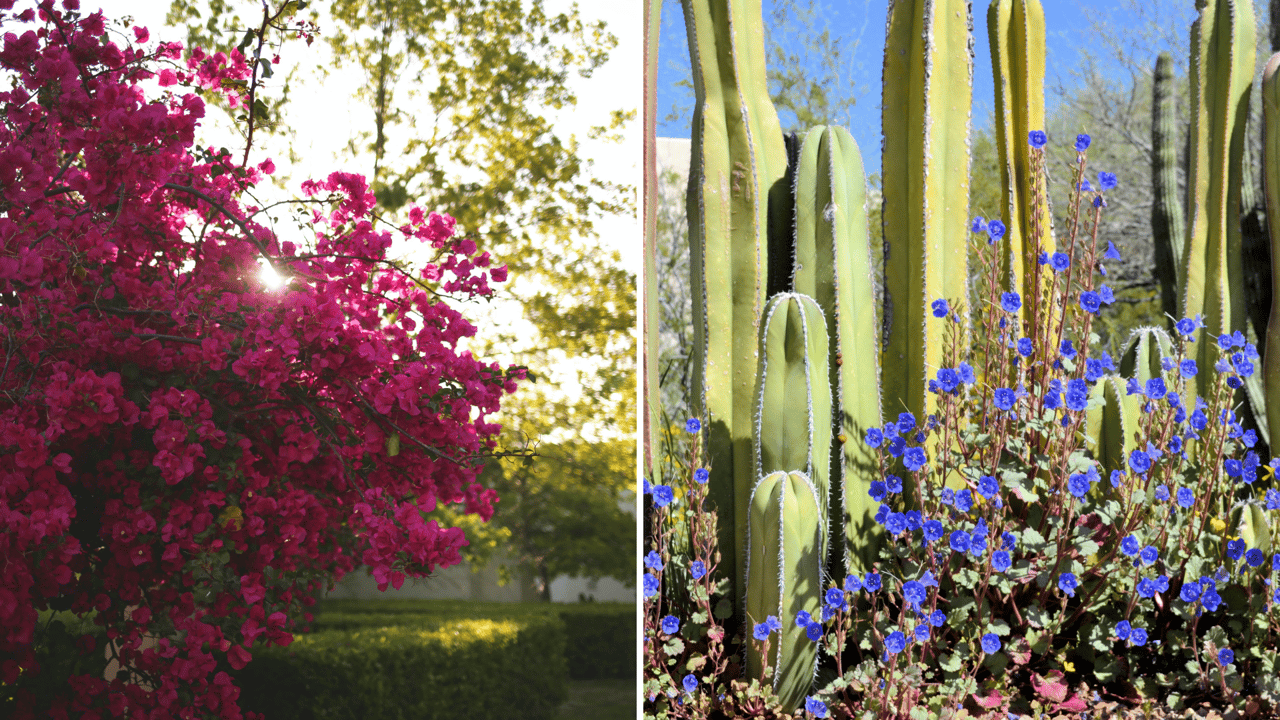BedBrock Landscaping led by Dennis Canedy have over 30 years of experience designing colorful, lush yards in our dry state with soaring summer temperatures. We aim to design sustainable landscaping that can sustain the weather challenges in Arizona while thriving on the resources set in place like drip irrigation systems and fertilizers. A complete landscape design include shrubs, flowers, trees, cacti, grass, and more often than not a variation of water features and/or pool design. By understanding the conditions of a property we can successfully design a landscape suited for the particular site. Sunlight, soil, air, space, and temperatures are all important factors that we consider when choosing plants and overall layout. Similar to interior design, landscape design utilize a variety of plant textures and layers to promote depth, and contrast using a variety of colors. Follow along as we go through the design ideas behind each plant.
Shrubs
Shrubs are versatile plants and can be found in a large variety of colors and sizes, they are unique in their longevity thriving in the desert climate, and act as a pop of color in your backyard during dormant seasons. Shrubs are loved by landscape designers as they serve many functions in design, they are small enough to fill a delicate space where trees would be overwhelming, yet they can fill large areas when grouped together to create a lush backdrop or oasis. They are often used to create vertical planes or privacy walls shading from wind or views.
Flowers
With a solid mix of annuals and perennials, you will enjoy colorful blooming flowers year-round in Arizona. Annuals last about 6 months, whereas perennials return year after year. The beauty of annuals is that you can change it up twice a year depending on temperature. One may alter the colors and flowers with a minimal investment. Flowers tend to require more care than other desert plants, however, with a drip irrigation system specifically designed for just annuals they tend thrive beautifully. Landscape designer Dennis claims that just about any seasonal flower can live in the desert with proper care and water.
Trees
When deciding on the perfect tree we consider growth, shade, maintenance, water supply, and drainage. Most homeowners want trees that look great year-round with shade protection and little debris. Trees can be found in all sizes with canopy diameter's from 15 to 50 feet offering a variety of design purposes. Fig, citrus, olive, mesquite, palo verde, and palm trees are some of the most common landscaping trees used in the desert with respect to the shape and color whether evergreen or deciduous. Trees provide the cornerstone for the landscape design. Proper placement is essential to complete the overall design, whether screening or providing special character.
Cacti and Succulents
These stunning, native desert plants acts as beautiful sculptures and design statements with its bold textures and evergreen colors. In Arizona, the cacti is a protected plant which takes decades to grow, making it an exclusive and majestic addition to any landscape plan. It serves as a connection between planned landscape design and the natural desert landscape in an unorganized manner. Cacti is an adaptable plant which can grow in a wide range of conditions, including containers and pots. Because of their unique ability to store water, they require way less than other plants. Aside from being a statement in itself, the cacti will surprise you with colorful flowers during the spring and summer months. In line with the cacti, succulents also thrive on low water conditions and can stand alone, or as a small group creating an interesting, organic effect. While all cacti are succulents not all succulents are cacti. They both have the ability to store water yet have different appearances. Yucca, agave, aloe, and ocotillos are the most common drought-tolerant plants in this area.
Grass
Living in Arizona, we have to be selective when choosing types of grass that can stand the heat and soaring sunshine. Hybrid Bermuda grass is one of our most utilized types due to its heat tolerance and is heavily utilized as the base grass for our homes. However, bermuda grass does not handle cold weather and goes dormant during the winter months leading to overseed with rye grass in the winter months to foster a fuller green lawn. In the summer, the rye grass will die off and the Bermuda grass will spring back to life.
By doing the groundwork of correct irrigation installation and proper hardscape to support the landscape design, there are many ways to create a beautiful lush garden in Arizona. We hope you can take away some basic gardening knowledge to better understand your garden or the changes you wish to make.


